In the ever-evolving landscape of orthopedic surgery, a groundbreaking review article published in the journal *Exploration of BioMed-X* (translated to English as “Exploration of BioMaterials-X”) is shedding new light on the future of hip replacements. The study, led by Antonio Ziranu of the Orthopedics & Traumatology Unit at Fondazione Policlinico Universitario Agostino Gemelli IRCSS in Rome, delves into the intricate world of 3D printed acetabular cups and their role in mitigating aseptic loosening, a primary cause of total hip arthroplasty (THA) failure.
The increasing prevalence of hip replacement surgeries has sparked a surge in research aimed at enhancing the longevity and success of these procedures. Aseptic loosening, a condition where the implant loosens without infection, is a significant challenge. Stress-shielding, a phenomenon where the bone loses density due to the implant bearing the load, is a critical factor in this process. “Understanding and addressing stress-shielding is pivotal for improving the long-term outcomes of hip arthroplasty,” Ziranu asserts.
The advent of 3D printed titanium orthopedic implants has opened new avenues in hip prosthetics. These customizable implants offer enhanced biocompatibility and the potential to reduce stress-shielding. Ziranu’s review meticulously evaluates the efficacy and reliability of these 3D printed acetabular cups, focusing on their impact on aseptic failure.
The study explores recent clinical and preclinical studies, highlighting the benefits and challenges of this emerging technology. Key factors such as biocompatibility, mechanical stability, osseointegration, and wear resistance are scrutinized. “The potential of 3D printed acetabular cups to revolutionize hip arthroplasty is immense,” Ziranu notes, “but it is essential to thoroughly understand their limitations and areas for improvement.”
The commercial implications for the medical device industry are substantial. As the demand for hip replacements continues to grow, the development of more durable and effective implants could lead to significant market opportunities. The insights gleaned from this review could guide manufacturers in refining their products, ultimately benefiting patients and healthcare systems alike.
This research not only advances our understanding of 3D printed acetabular cups but also paves the way for future innovations in the field. As Ziranu’s work demonstrates, the intersection of advanced manufacturing techniques and orthopedic surgery holds tremendous promise for improving patient outcomes and reshaping the future of hip arthroplasty.

